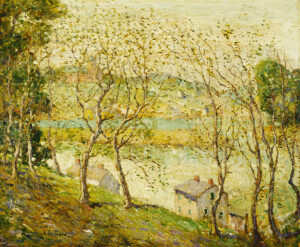And now it is March, and nearly spring, and since it is very late at night, I will make this short and sweet: Here is your printable Convivio Book of Days Calendar for March. It’s an astonishingly busy month: the vernal equinox in the Northern Hemisphere, plus Ramadan and Holi and Easter and all the minor holidays that generally come with March. The first of them comes today: It is St. David’s Day, sacred to Wales. It’s a day for leeks and daffodils, but even better: Welsh Cakes:
W E L S H C A K E S
It’s not uncommon to find recipes for Welsh Cakes that call for regular granulated sugar, butter, and nutmeg, but the traditional recipe will add lard to the mix, use caster sugar in place of the regular sugar, and will be flavored with the more mysterious flavor of mace. If you want the best Welsh Cakes, stick to the traditional version. If you can’t find caster sugar, make your own: pulse regular granulated sugar in a blender until very fine. Do not use powdered confectioners’ sugar, which has added corn starch.
3 cups all purpose flour
½ cup caster sugar
1 ½ teaspoons baking powder
1 teaspoon ground mace
½ teaspoon cinnamon
½ teaspoon salt
6 tablespoons lard
6 tablespoons butter
¾ cup dried currants
2 eggs, beaten lightly
3 to 4 tablespoons milk
granulated sugar
Whisk together the flour, caster sugar, baking powder, mace, cinnamon, and salt in a mixing bowl, then work in the butter and lard with your fingers until the mixture has the texture of course crumbs. It’s ok if some larger chunks of butter remain. Mix in the currants. Add the beaten egg, working it into the mixture, adding just enough milk to form a soft dough that is not too sticky. Wrap; chill in the refrigerator for 30 minutes or until you are ready to make the cakes.
Turn the dough out onto a floured board and roll to a thickness of about ¼”. Using a biscuit cutter (scalloped, if you have one), cut into rounds. Gather up any remnants to roll out again and cut more cakes.
Heat a lightly buttered skillet (cast iron works great) over low to medium heat, cooking the cakes until each side is lightly browned (about 3 to 4 minutes… if they’re cooking quicker than that, lower the heat). Let the cakes cool for a minute or two, then set each in a bowl of granulated sugar, allowing sugar to coat both sides and the edges. Best served warm, split, with butter and jam, or, for a more savory treat, with cheese and leeks, at a table set with a small vase of daffodils.
SHOP OUR SPRING SALE!
Winter is quickly melting into spring and at our online catalog right now, you may use discount code BLOSSOM to save $10 on your $85 purchase, plus get free domestic shipping, too. That’s a total savings of $19.50. Spend less than $85 and our flat rate shipping fee of $9.50 applies. Traditional Easter goods from Germany have been arriving, and new fillable handmade paper eggs should be on our website by Monday. CLICK HERE to shop; you know we appreciate your support immensely.
A STORY FOR WINTER
Before Winter completely melts away, here is a short bedtime story for a chilly night that I recently read for Stay Awake: Bedtime Stories for Kids & Sleepy Adults, from the Jaffe Center for Book Arts. It’s called “The Magic Porridge Pot,” and you’ll find this story (Episode No. 11) and nine others in the Stay Awake Library at the Jaffe Center’s Vimeo Channel. If you like what we do there at Stay Awake, please consider following the series on Instagram @stayawakebedtimestories … I do love this storytelling project, and it would be awfully nice to see the project get to a hundred followers, at least! Thank you!
Image: Our cover star for this month’s calendar is a painting called “Springtime, Harlem River” by Ernest Lawson. Oil on canvas, circa 1900 – 1910 [Public domain, via Wikimedia Commons].
